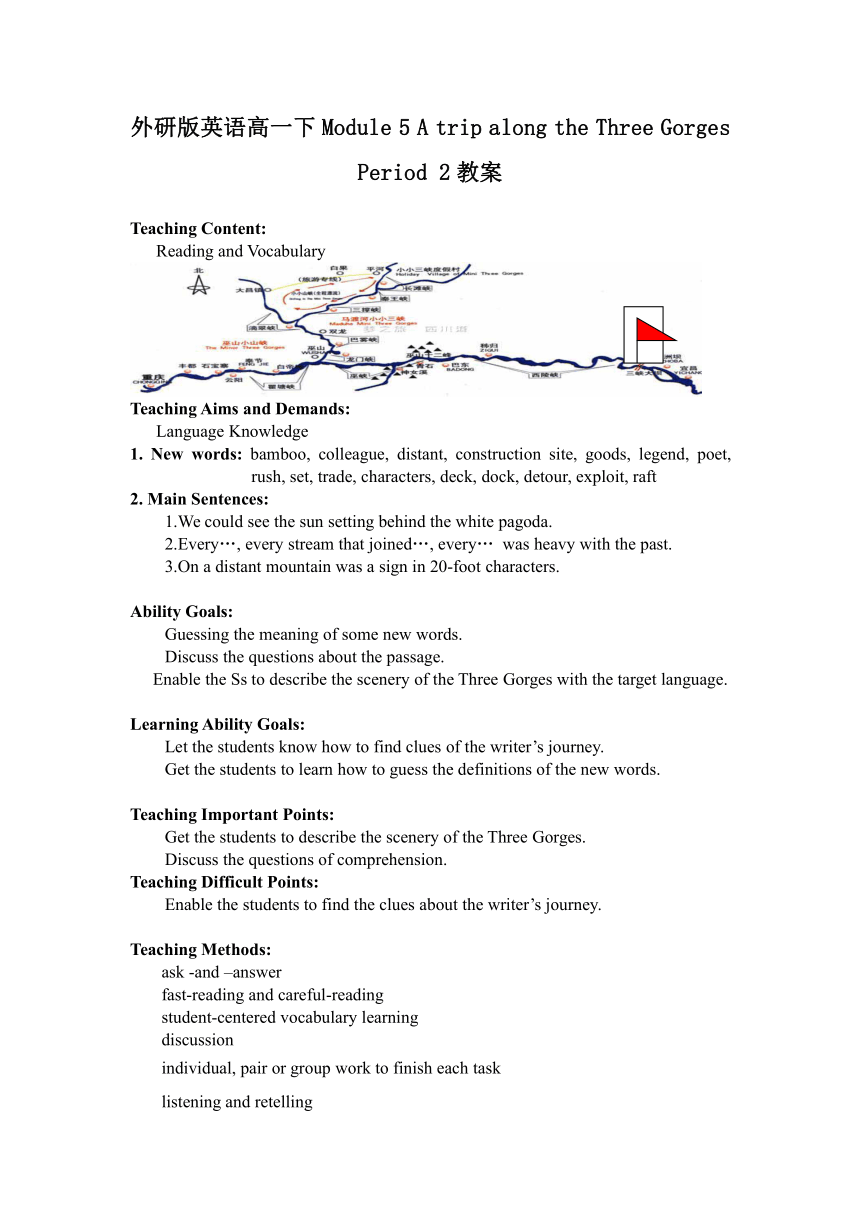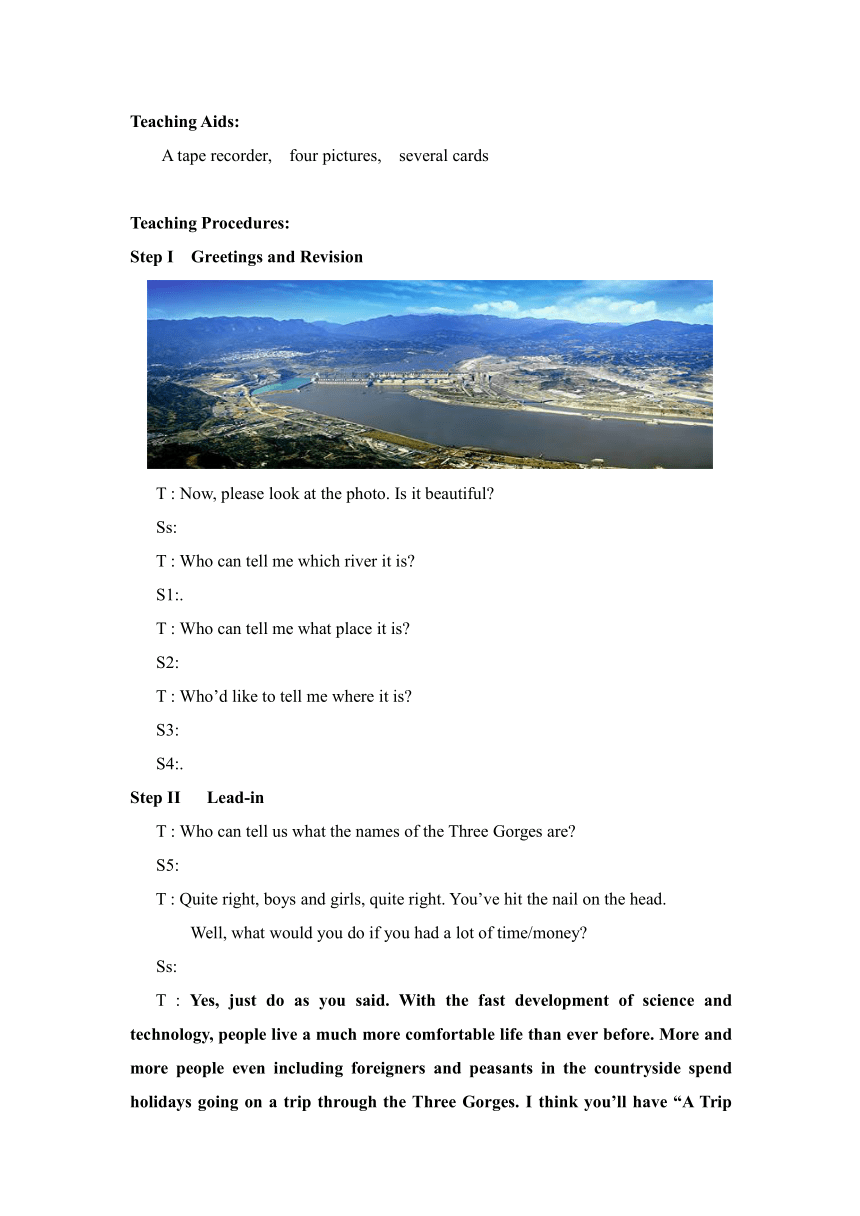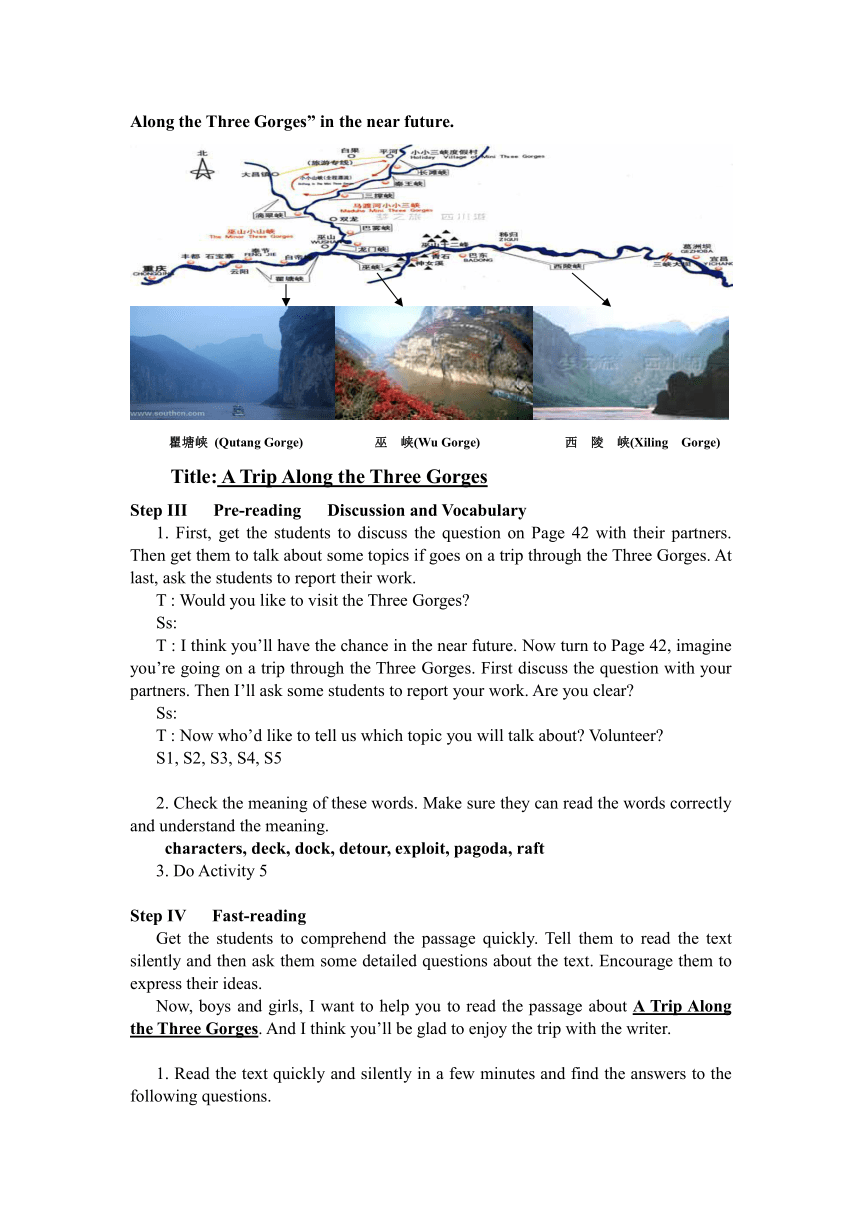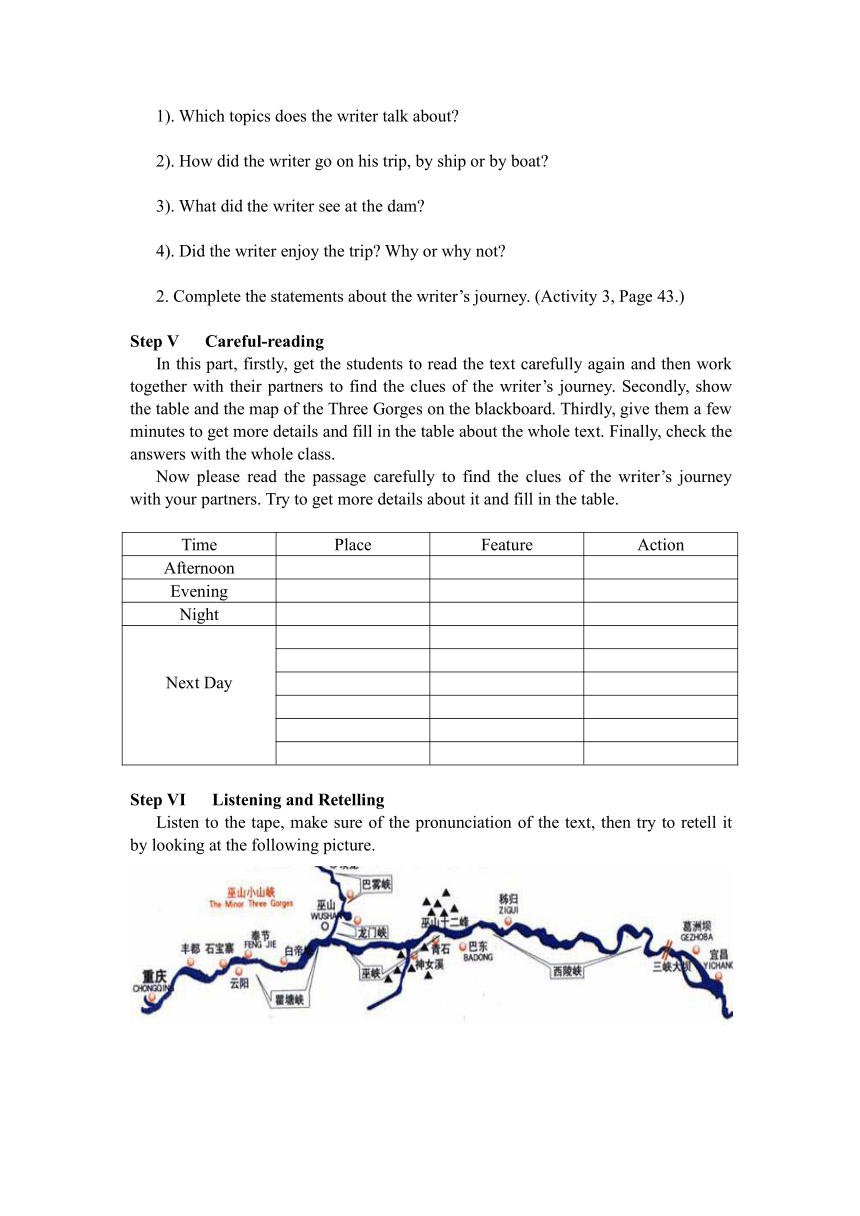高一下Module 5 A trip along the Three Gorges Period 2教案[下学期]
文档属性
| 名称 | 高一下Module 5 A trip along the Three Gorges Period 2教案[下学期] |  | |
| 格式 | rar | ||
| 文件大小 | 292.1KB | ||
| 资源类型 | 教案 | ||
| 版本资源 | 外研版 | ||
| 科目 | 英语 | ||
| 更新时间 | 2006-08-02 21:56:00 | ||
图片预览




文档简介
外研版英语高一下Module 5 A trip along the Three Gorges
Period 2教案
Teaching Content:
Reading and Vocabulary
Teaching Aims and Demands:
Language Knowledge
1. New words: bamboo, colleague, distant, construction site, goods, legend, poet, rush, set, trade, characters, deck, dock, detour, exploit, raft
2. Main Sentences:
1.We could see the sun setting behind the white pagoda.
2.Every…, every stream that joined…, every… was heavy with the past.
3.On a distant mountain was a sign in 20-foot characters.
Ability Goals:
Guessing the meaning of some new words.
Discuss the questions about the passage.
Enable the Ss to describe the scenery of the Three Gorges with the target language.
Learning Ability Goals:
Let the students know how to find clues of the writer’s journey.
Get the students to learn how to guess the definitions of the new words.
Teaching Important Points:
Get the students to describe the scenery of the Three Gorges.
Discuss the questions of comprehension.
Teaching Difficult Points:
Enable the students to find the clues about the writer’s journey.
Teaching Methods:
ask -and –answer
fast-reading and careful-reading
student-centered vocabulary learning
discussion
individual, pair or group work to finish each task
listening and retelling
Teaching Aids:
A tape recorder, four pictures, several cards
Teaching Procedures:
Step I Greetings and Revision
T : Now, please look at the photo. Is it beautiful
Ss:
T : Who can tell me which river it is
S1:.
T : Who can tell me what place it is
S2:
T : Who’d like to tell me where it is
S3:
S4:.
Step II Lead-in
T : Who can tell us what the names of the Three Gorges are
S5:
T : Quite right, boys and girls, quite right. You’ve hit the nail on the head.
Well, what would you do if you had a lot of time/money
Ss:
T : Yes, just do as you said. With the fast development of science and technology, people live a much more comfortable life than ever before. More and more people even including foreigners and peasants in the countryside spend holidays going on a trip through the Three Gorges. I think you’ll have “A Trip Along the Three Gorges” in the near future.
瞿塘峡 (Qutang Gorge) 巫 峡(Wu Gorge) 西 陵 峡(Xiling Gorge)
Title: A Trip Along the Three Gorges
Step III Pre-reading Discussion and Vocabulary
1. First, get the students to discuss the question on Page 42 with their partners. Then get them to talk about some topics if goes on a trip through the Three Gorges. At last, ask the students to report their work.
T : Would you like to visit the Three Gorges
Ss:
T : I think you’ll have the chance in the near future. Now turn to Page 42, imagine you’re going on a trip through the Three Gorges. First discuss the question with your partners. Then I’ll ask some students to report your work. Are you clear
Ss:
T : Now who’d like to tell us which topic you will talk about Volunteer
S1, S2, S3, S4, S5
2. Check the meaning of these words. Make sure they can read the words correctly and understand the meaning.
characters, deck, dock, detour, exploit, pagoda, raft
3. Do Activity 5
Step IV Fast-reading
Get the students to comprehend the passage quickly. Tell them to read the text silently and then ask them some detailed questions about the text. Encourage them to express their ideas.
Now, boys and girls, I want to help you to read the passage about A Trip Along the Three Gorges. And I think you’ll be glad to enjoy the trip with the writer.
1. Read the text quickly and silently in a few minutes and find the answers to the following questions.
1). Which topics does the writer talk about
2). How did the writer go on his trip, by ship or by boat
3). What did the writer see at the dam
4). Did the writer enjoy the trip Why or why not
2. Complete the statements about the writer’s journey. (Activity 3, Page 43.)
Step V Careful-reading
In this part, firstly, get the students to read the text carefully again and then work together with their partners to find the clues of the writer’s journey. Secondly, show the table and the map of the Three Gorges on the blackboard. Thirdly, give them a few minutes to get more details and fill in the table about the whole text. Finally, check the answers with the whole class.
Now please read the passage carefully to find the clues of the writer’s journey with your partners. Try to get more details about it and fill in the table.
Time Place Feature Action
Afternoon
Evening
Night
Next Day
Step VI Listening and Retelling
Listen to the tape, make sure of the pronunciation of the text, then try to retell it by looking at the following picture.
in 1997, Peter Hessler, a young American teacher, go, the Three Gorges, colleague.
the first day, leave, Fuling, sail, downstream, travel, Qutang Gorge, where, rush, mountains.
the next morning, go through, Wu Gorge, pass, the Xiang River, Qu Yuan, come out of, Xiling Gorge, the construction site, dam, take, pictures, see, the Chinese flag, blowing, sign, say, build, the Three Gorges Dam, exploit, the Yangtze River..
Step Ⅶ Moral Education
T : What lesson can you learn from this passage
Ss: (S1, S2, S3, S4…)
T : After learning the passage, we students should love nature, love life. We only regret that we have but one life to lose for our country. We should make up our minds to make the Three Gorges more beautiful than ever before.
Step Ⅷ Homework
1. Read the text again and again until you can recite it.
2. Write a short paragraph about A Trip Along the Three Gorges, using about 100 words.
学生练习
Step III Pre-reading Discussion and Vocabulary
T : Would you like to visit the Three Gorges
Ss:
T : I think you’ll have the chance in the near future. Now turn to Page 42, imagine you’re going on a trip through the Three Gorges. First discuss the question with your partners. Then I’ll ask some students to report your work. Are you clear
Ss:
T : Now who’d like to tell us which topic you will talk about
S1: I think I’ll talk about…
S2: I’d like to talk about…
S3: I’ll talk about…
S4: I think it’s worth describing…
S5: I prefer to talk about…
2. Check the meaning of these words. Make sure they can read the words correctly and understand the meaning.
3. Do Activity 5
a place where boats load and unload
a simple boat made of piece of wood tied together
a Buddhist temple
a change of route
a floor on a boat
marks or signs used in writing
to use or make advantage of
Step IV Fast-reading
1. Read the text quickly and silently in 5 minutes and find the answers to the following questions.
1). Which topics does the writer talk about
2). How did the writer go on his trip, by ship or by boat
3). What did the writer see at the dam
4). Did the writer enjoy the trip Why or why not
2. Complete the statements about the writer’s journey. (Activity 3, Page 43.)
1). Peter and his friend went downstream .
a. to see the dam b. to see the Three Gorges c. to get to Fuling
2). He chose the Jiangyou boat because .
a. it was crowded b. it didn’t stop at temple c. it didn’t usually carry foreigners
3). When they started the trip it was .
a. sunny b. cold c. evening
4). When the boat went through the first gorge, Peter and his friend .
a. took lots of photographs b. spent most of the time on deck c. were slept
5).When they reached the site of the dam came to look.
a. everyone b. no one c. only the foreigners
6). Peter was impressed by the Yangtze River’s sense of .
a. power b. history c. danger
Step V Careful-reading
Now please read the passage carefully to find the clues of the writer’s journey with your partners. Try to get more details about it and fill in the table.
Time Place Feature Action
Afternoon .Jiangyou Fuling Sailed
Evening Fengdu Beautiful
Night Slept
Next Day Wushan ∕
The Daning River Small Saw
Big
The Xiang River Historical
∕
Took pictures
Step VI Listening and Retelling
Listen to the tape, make sure of the pronunciation of the text, then try to retell it by looking at the following picture.
in 1997, Peter Hessler, a young American teacher, go, the Three Gorges, colleague.
the first morning, leave, Fuling, sail, downstream, travel, Qutang Gorge, where, rush, mountains.
The next morning, go through, Wu Gorge, pass, the Xiang River, Qu Yuan, come out of, Xiling Gorge, the construction site, dam, take, pictures, see, the Chinese flag, blowing, sign, say, build, the Three Gorges Dam, exploit, the Yangtze River.
Characters, deck, dock, detour, exploit, pagoda, raft
Period 2教案
Teaching Content:
Reading and Vocabulary
Teaching Aims and Demands:
Language Knowledge
1. New words: bamboo, colleague, distant, construction site, goods, legend, poet, rush, set, trade, characters, deck, dock, detour, exploit, raft
2. Main Sentences:
1.We could see the sun setting behind the white pagoda.
2.Every…, every stream that joined…, every… was heavy with the past.
3.On a distant mountain was a sign in 20-foot characters.
Ability Goals:
Guessing the meaning of some new words.
Discuss the questions about the passage.
Enable the Ss to describe the scenery of the Three Gorges with the target language.
Learning Ability Goals:
Let the students know how to find clues of the writer’s journey.
Get the students to learn how to guess the definitions of the new words.
Teaching Important Points:
Get the students to describe the scenery of the Three Gorges.
Discuss the questions of comprehension.
Teaching Difficult Points:
Enable the students to find the clues about the writer’s journey.
Teaching Methods:
ask -and –answer
fast-reading and careful-reading
student-centered vocabulary learning
discussion
individual, pair or group work to finish each task
listening and retelling
Teaching Aids:
A tape recorder, four pictures, several cards
Teaching Procedures:
Step I Greetings and Revision
T : Now, please look at the photo. Is it beautiful
Ss:
T : Who can tell me which river it is
S1:.
T : Who can tell me what place it is
S2:
T : Who’d like to tell me where it is
S3:
S4:.
Step II Lead-in
T : Who can tell us what the names of the Three Gorges are
S5:
T : Quite right, boys and girls, quite right. You’ve hit the nail on the head.
Well, what would you do if you had a lot of time/money
Ss:
T : Yes, just do as you said. With the fast development of science and technology, people live a much more comfortable life than ever before. More and more people even including foreigners and peasants in the countryside spend holidays going on a trip through the Three Gorges. I think you’ll have “A Trip Along the Three Gorges” in the near future.
瞿塘峡 (Qutang Gorge) 巫 峡(Wu Gorge) 西 陵 峡(Xiling Gorge)
Title: A Trip Along the Three Gorges
Step III Pre-reading Discussion and Vocabulary
1. First, get the students to discuss the question on Page 42 with their partners. Then get them to talk about some topics if goes on a trip through the Three Gorges. At last, ask the students to report their work.
T : Would you like to visit the Three Gorges
Ss:
T : I think you’ll have the chance in the near future. Now turn to Page 42, imagine you’re going on a trip through the Three Gorges. First discuss the question with your partners. Then I’ll ask some students to report your work. Are you clear
Ss:
T : Now who’d like to tell us which topic you will talk about Volunteer
S1, S2, S3, S4, S5
2. Check the meaning of these words. Make sure they can read the words correctly and understand the meaning.
characters, deck, dock, detour, exploit, pagoda, raft
3. Do Activity 5
Step IV Fast-reading
Get the students to comprehend the passage quickly. Tell them to read the text silently and then ask them some detailed questions about the text. Encourage them to express their ideas.
Now, boys and girls, I want to help you to read the passage about A Trip Along the Three Gorges. And I think you’ll be glad to enjoy the trip with the writer.
1. Read the text quickly and silently in a few minutes and find the answers to the following questions.
1). Which topics does the writer talk about
2). How did the writer go on his trip, by ship or by boat
3). What did the writer see at the dam
4). Did the writer enjoy the trip Why or why not
2. Complete the statements about the writer’s journey. (Activity 3, Page 43.)
Step V Careful-reading
In this part, firstly, get the students to read the text carefully again and then work together with their partners to find the clues of the writer’s journey. Secondly, show the table and the map of the Three Gorges on the blackboard. Thirdly, give them a few minutes to get more details and fill in the table about the whole text. Finally, check the answers with the whole class.
Now please read the passage carefully to find the clues of the writer’s journey with your partners. Try to get more details about it and fill in the table.
Time Place Feature Action
Afternoon
Evening
Night
Next Day
Step VI Listening and Retelling
Listen to the tape, make sure of the pronunciation of the text, then try to retell it by looking at the following picture.
in 1997, Peter Hessler, a young American teacher, go, the Three Gorges, colleague.
the first day, leave, Fuling, sail, downstream, travel, Qutang Gorge, where, rush, mountains.
the next morning, go through, Wu Gorge, pass, the Xiang River, Qu Yuan, come out of, Xiling Gorge, the construction site, dam, take, pictures, see, the Chinese flag, blowing, sign, say, build, the Three Gorges Dam, exploit, the Yangtze River..
Step Ⅶ Moral Education
T : What lesson can you learn from this passage
Ss: (S1, S2, S3, S4…)
T : After learning the passage, we students should love nature, love life. We only regret that we have but one life to lose for our country. We should make up our minds to make the Three Gorges more beautiful than ever before.
Step Ⅷ Homework
1. Read the text again and again until you can recite it.
2. Write a short paragraph about A Trip Along the Three Gorges, using about 100 words.
学生练习
Step III Pre-reading Discussion and Vocabulary
T : Would you like to visit the Three Gorges
Ss:
T : I think you’ll have the chance in the near future. Now turn to Page 42, imagine you’re going on a trip through the Three Gorges. First discuss the question with your partners. Then I’ll ask some students to report your work. Are you clear
Ss:
T : Now who’d like to tell us which topic you will talk about
S1: I think I’ll talk about…
S2: I’d like to talk about…
S3: I’ll talk about…
S4: I think it’s worth describing…
S5: I prefer to talk about…
2. Check the meaning of these words. Make sure they can read the words correctly and understand the meaning.
3. Do Activity 5
a place where boats load and unload
a simple boat made of piece of wood tied together
a Buddhist temple
a change of route
a floor on a boat
marks or signs used in writing
to use or make advantage of
Step IV Fast-reading
1. Read the text quickly and silently in 5 minutes and find the answers to the following questions.
1). Which topics does the writer talk about
2). How did the writer go on his trip, by ship or by boat
3). What did the writer see at the dam
4). Did the writer enjoy the trip Why or why not
2. Complete the statements about the writer’s journey. (Activity 3, Page 43.)
1). Peter and his friend went downstream .
a. to see the dam b. to see the Three Gorges c. to get to Fuling
2). He chose the Jiangyou boat because .
a. it was crowded b. it didn’t stop at temple c. it didn’t usually carry foreigners
3). When they started the trip it was .
a. sunny b. cold c. evening
4). When the boat went through the first gorge, Peter and his friend .
a. took lots of photographs b. spent most of the time on deck c. were slept
5).When they reached the site of the dam came to look.
a. everyone b. no one c. only the foreigners
6). Peter was impressed by the Yangtze River’s sense of .
a. power b. history c. danger
Step V Careful-reading
Now please read the passage carefully to find the clues of the writer’s journey with your partners. Try to get more details about it and fill in the table.
Time Place Feature Action
Afternoon .Jiangyou Fuling Sailed
Evening Fengdu Beautiful
Night Slept
Next Day Wushan ∕
The Daning River Small Saw
Big
The Xiang River Historical
∕
Took pictures
Step VI Listening and Retelling
Listen to the tape, make sure of the pronunciation of the text, then try to retell it by looking at the following picture.
in 1997, Peter Hessler, a young American teacher, go, the Three Gorges, colleague.
the first morning, leave, Fuling, sail, downstream, travel, Qutang Gorge, where, rush, mountains.
The next morning, go through, Wu Gorge, pass, the Xiang River, Qu Yuan, come out of, Xiling Gorge, the construction site, dam, take, pictures, see, the Chinese flag, blowing, sign, say, build, the Three Gorges Dam, exploit, the Yangtze River.
Characters, deck, dock, detour, exploit, pagoda, raft
